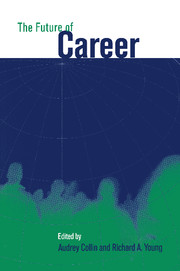Book contents
- Frontmatter
- Contents
- Notes on contributors
- Acknowledgements
- 1 Introduction: framing the future of career
- Part 1 Changing contexts
- 2 ‘Fracture lines’ in the career environment
- 3 Some contributions of sociology to the understanding of career
- 4 Renovating the psychology of careers for the twenty-first century
- 5 Changing career: the role of values
- 6 Dancing to the music of time
- Part 2 New perspectives
- Part 3 New directions for theory, practice and policy
- Author index
- Subject index
6 - Dancing to the music of time
Published online by Cambridge University Press: 06 January 2010
- Frontmatter
- Contents
- Notes on contributors
- Acknowledgements
- 1 Introduction: framing the future of career
- Part 1 Changing contexts
- 2 ‘Fracture lines’ in the career environment
- 3 Some contributions of sociology to the understanding of career
- 4 Renovating the psychology of careers for the twenty-first century
- 5 Changing career: the role of values
- 6 Dancing to the music of time
- Part 2 New perspectives
- Part 3 New directions for theory, practice and policy
- Author index
- Subject index
Summary
The return of the comet Hale-Bopp in 1997 connected us to a far distant past and future. By making the sweep of time and space visible in the heavens to the naked eye, it offered some measure and meaning of the vastness of time, and spoke of our lineage as human beings on our planet in space. In contrast, in the run-up to the new millennium, our apocalyptic vision was of the havoc to be wrought should computers fail to recognise the start of the year 2000, and no longer be able to translate the future into the present. Today's experiences of time are ‘increasingly instantaneous and glacial or evolutionary’ (Lash & Urry, 1994, p. 9). While ‘glacial’ time ‘moves back out of immediate human history and forwards into a wholly unspecifiable future’ (p. 243), ‘the future is dissolving into the present’. It is within this context of ‘post-modern time’ (p. 243) that we have to view the future of career.
Revolutions in information, communications, transport, and other technologies are having a major impact on career. According to analysts of this age of ‘high modernity’ (Giddens, 1991, p. 4), of ‘the network society’ (Castells, 1996, p. 433), ‘disorganized capitalism’ (Lash & Urry, 1994, p. 2), and ‘flexible accumulation’ (Harvey, 1990, p. 124), they are also transforming the temporal and spatial dimensions of societies and of individual lives. Indeed, Giddens ‘has placed the analysis of time (and space) at the very heart of contemporary social theory’ (Lash & Urry, 1994, p. 230).
- Type
- Chapter
- Information
- The Future of Career , pp. 83 - 98Publisher: Cambridge University PressPrint publication year: 2000
- 9
- Cited by



